
- Permbajtja
- prev
- next
- prev
- next
HIGHLIGHT: EDOARDO TRESOLDI
Early life and career
Edoardo Tresoldi was born on December 19, 1987 (age 34) in Milan, Italy
Edoardo Tresoldi is an Italian sculptor and set designer, known for his astonishingly realistic, transparent sculptures made from metallic wire mesh, he was brought up inMilan where, at the age of nine, he began to experiment with different techniques and artistic languages under the guidance of the painter Mario Straforini. In 2009 he moved to Rome and he began to work in different areas. Cinema, music, set design and sculpture provided him a heterogeneous vision of the arts and they became a platform for experimentation. Since 2013 he has been creating interventions for public spaces, focusing his research on the genius loci and the study of landscape elements. His work involves also adeptly molding wire mesh into intricate sculptures of animals, humans and buildings, and installing them at strategic locations perfectly integrated to the surroundings, with the aim of inscribing a specific sense of time and space to them. His works speak about the fine line between freedom and captivity, and how man influences the environment he lives in
They have been inserted into public spaces, archaeological contexts, contemporary art festivals, music festivals and group exhibitions. In 2016, in collaboration with MIBACT, he worked on the restoration of the Christian Basilica of Santa Maria in Siponto, a unique convergence between contemporary art and archaeology.
In 2015, Edoardo’s collaborated with street artist Gonzalo Borondocreating Chained, a piece that combines a mural and wire mesh sculpture depicting a man climbing out of a wall, transitioning from a 2D mural to a 3D sculpture. The piece was created for the art event organized by Wunderkammern Gallery who invited nine important urban artists to create outdoor installations in the city of Milan.
Awards
In 2017 he was cited by “Forbes” as one of the most influential 30 artists Under 30 in Europe. In 2018 he participated in the Coachella Valley Music and Arts Festival in Indio, California, where he made “Etherea”, a monumental temporary installation.
Works
Edoardo is a master of his craft. A single glance at any one of his sculptures ranging from smaller statues to buildings of massive scale is enough for the viewer to realize the level of intricacy and delicate precision that is required to bring these sculptures to life. Using only pieces of bent metal, Tresoldi skillfully represents human form through well-executed natural body language, beyond realistic facial expressions and meticulously placed creases in the clothing.Transforming a mundane industrial material into delicately crafted three-dimensional figures, the artist manages to create artworks in which forms create volumes. Feelings serve as the real protagonists of the narrative – Edoardo develops a story or a character and concretizes them through the creation of the sculpture.
Incipit in Camerota, Italy
Tresoldi’s large-scale architectural installations – such as Incipit and LIFT – are especially captivating and mesmerizing.
Incipit is an architecturally-inspired towering installation built in the scenic city of Marina di Camerota, as a part of a local festival Meeting del Mare 2015. Composed of eight columns joined together by semicircular arches, the sculpture is shaped from wire mesh, radiating translucence and serenity. The thin wire, with its countless tiny squares, makes the artist’s massive creation mostly see through. Against the blue sky, Incipit appears as an ethereal, almost ghostly form. At its very top, a flock of embedded wire birds, in a perpetual stance of flight, are reaching for the sky.
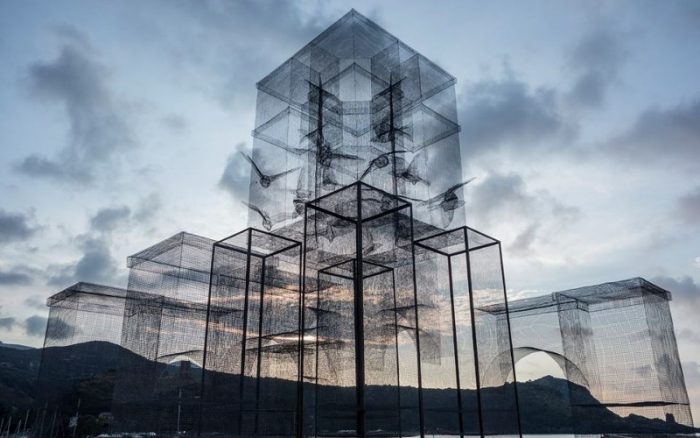
Incipit
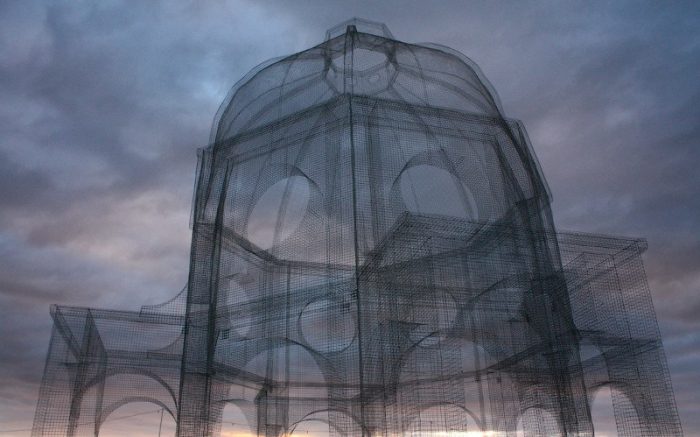
L I F T
Control for Animal - Borondo exhibition
The artist had another collaboration with Borondo. He participated in the Animal exhibition, and for the occasion, he produced a monumental installation. Later, Edoardo Tresoldi unveiled his first ever limited edition of studio-made sculptures entitled Reason, featuring a stunning wire-mesh based bird.
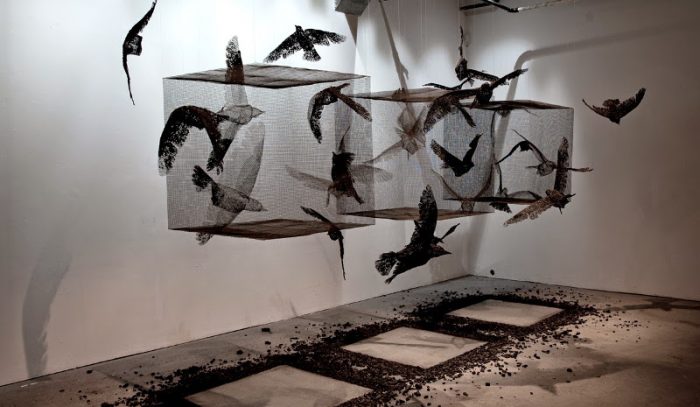
Reason, limited edition sculptures
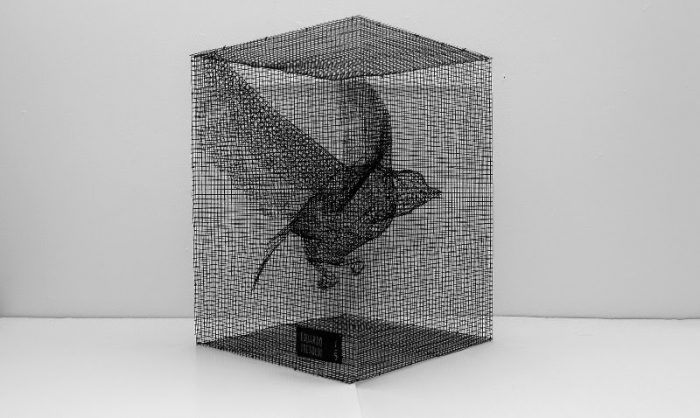
Wire mesh sculptures
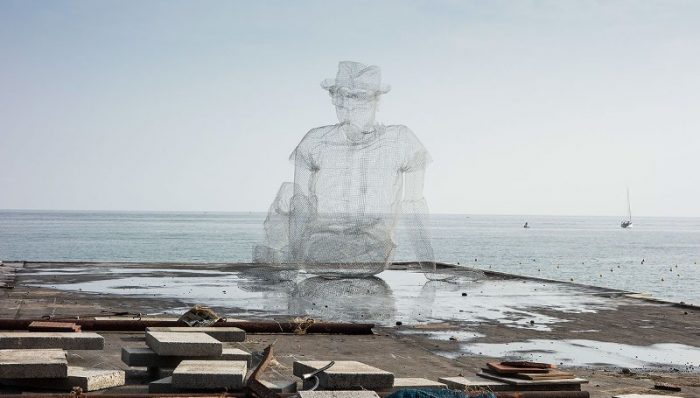
Tresoldi says….
The Heteronomy of architecture is understood as the condition to be pursued if one sets one’s goal of producing buildings that belong to one’s own time, to the complex interweaving of values and needs that characterise it, to the place where they arise.
Heteronomy in architecture allows us to break the boundaries still linked to the concept of the now obsolete scientific sector. One of the people who recently successfully pursued the road of the Heteronomy of architecture and art through a borderline path is Edoardo Tresoldi, an Italian sculptor who “investigates” the poetics of the dialogue between man and landscape using architectural language as an expressive tool and key to reading space. The artist plays with the transparency of the metal mesh to transcend the space-time dimension and narrate a dialogue between Art and World.Five themes were taken into consideration to address the issue of the heteronomy of architecture with the Sculptor Tresoldi.The first one concerns the PLACE, because architecture, as materially utilitarian, is completely conditioned by the material and immaterial context of which it is part. The second theme tackled is the PROJECT, understood as an action of prefiguration, of casting ahead, beyond cultural, social and historical influences. According to Tresoldi, an author can be compared to an organism that absorbs certain concepts, lives them and finally releases them through the creative act. When the artist finds himself creating a work, he prefers to go to the place to try to intercept the dynamics of the place in which he can find himself and express himself.
When he connects with a place and sees the key to intercept certain elements, he lives this process in a partially selfish way, while in the phase of elaboration of the installation the artist expresses himself through recognizable languages common to all. From here the goal is to intercept and work with simple archetypes that make his works as direct as possible: “the process is similar to that of composing a love song that, most of the time, is written by the author in a specific moment lived with a specific person. In that case, the experience is extremely personal but the moment it is told, it becomes a choral experience”. All of this is the synthesis that allows us to connect deeply with what is around us.
By working with transparency, the sculptor has tried to translate his idea into the language of contemporaneity. This pure relationship with the elements is also what allows us to understand how the meanings of certain archetypes (the column, transparency) have evolved over time. Time, in Tresoldi, has made his idea of transparency change, transforming it into the concept of Absent Matter. Starting from a concept, from an instinct towards a material, one can see how his work on absence has transformed over time. Although today many people associate his work with wireframe drawings, in reality Tresoldi’s work arises from a strongly real, material, analogue action. In fact, his work is based on “sewing” the net, an act that physically would have been conceivable even in the past. In fact, before building a permanent work, the festival allows to have an effect on the temporary not only in terms of structure but also at the level of imaginable society: When for a week several people inhabit a place, that place becomes a city. From this point of view, festivals are a very formative experience where practice manages to have compared to theory a gap that is the dirt of humanity.
As he himself announced, another project to which he is dedicating himself is STUDIO STUDIO STUDIO. He collaborates all the time with his team, a team formed over time by numerous collaborations, which explains very well the fact that each member of the team belongs to a different field from the other.
Source: https://www.edoardotresoldi.com/